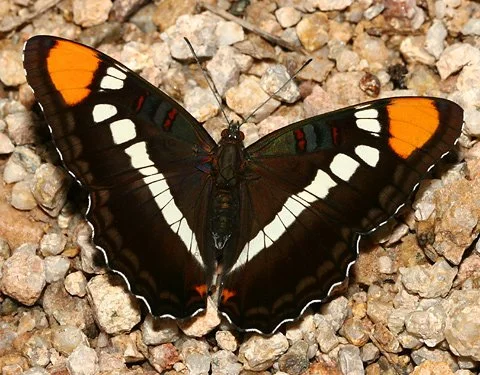A Kaleidoscope, Butterflies, and When Everything Shifts
In the Valley of the Sun where we live, spring is almost over--at least as far as the wildflowers go. The fragile petals folded and left many weeks ago, with only the saguaro cactus still sporting their twenty-four hour attractants for nectar seekers.
A two-hour drive north brought spring into full bloom again at Christopher Creek, Arizona: orange poppies, New Mexico groundsel, purple lupine, and rock daisies.
But also in bloom were some new varieties for my journal, with interesting monikers: The aptly named Cowboy's Fried Egg with its large white blooms and bright gold centers, the Seep Monkeyflower, and the Bastard Toadflax--an unassuming plant with tiny star-shaped flowers that is parasitic, obtaining nutrients from its neighbors.
We hiked the eight-mile, out-and-back trail along Horton's Creek under the shade of Ponderosa pines, spruce, and a variety of oak trees as unnamed birds called out their desert songs. A popular trail, we met many hikers, from retired folks to young families, and it seemed everyone had a dog in tow: a leash-pulling retriever, a corgi being run off its short legs, and a young beagle puppy, all wagging tail and dangling tongue.
Also in attendance were butterflies. So many flitting among the flowers in a variety of colors: lavender, orange, yellow, white--none staying long enough for a photo.
Dogs. People. Wildflowers. Trees. Birds. Butterflies.
A day for over-loading the senses, for filling the soul with more than digital images, unending emails, and deadlines. A day for the surround-sound reality of a world created by God who loves.
A day for celebrating eight years of being a cancer survivor.
Eight years. We didn't pick the day because of the date on the calendar. We headed out of town because I was soul thirsty.
We ate lunch next to an offshoot of Horton's Spring, where pure water trickled from an old pipe that jutted out from a crumbly concrete foundation. A large butterfly caught my eye--dark with white stripes and bold orange spots--as it dipped and fluttered under the maple canopy while I munched on a peanut butter granola bar. A California Sister.
"What do you call a group of butterflies?" I asked as the California Sister headed toward the sunlight.
"Not sure," my husband answered as he angled his phone for a shot of running water.
"A flutter? A swarm?"
Neither seemed to fit.
A kaleidoscope, according to a later computer search. A group of butterflies is called a kaleidoscope--from the Greek word Kalos for beautiful and eidos for shape.
I have a small kaleidoscope on a table in my home next to items we have collected on desert adventures. The wood base of the kaleidoscope was carved by a cousin, who was an active farmer before a fall in a grain elevator left him paralyzed. He took to wood carving and creating kaleidoscopes--wood cylinders with tiny pieces of colored glass that shift in the light.
My cousin experienced the shifting. As have I. A fall and a shattered spine. A diagnosis of cancer. Realities that shifted a life. And I know you have those places too. (Don't we ALL have those places?)
I watch the California Sister dip near the clear spring and know that even after eight years, I am still learning how to discover beauty in my shifting realities.
The sunlight plays on the water.
Beautiful shapes in the desert.
*****
You can purchase Under a Desert Sky at Baker Publishing Group, Amazon, Barnes and Noble, Target, Christian Books and More, Liveway, Books-a-Million and Parable Christian Stores. Audio and Ebook versions are also available. If you live in the Chandler area, Sibley's West also carries copies of the book.Click here to read an excerpt.And another video, below:


